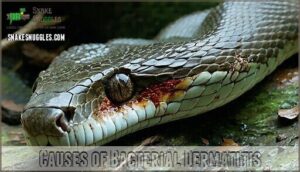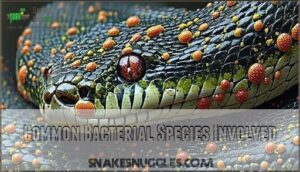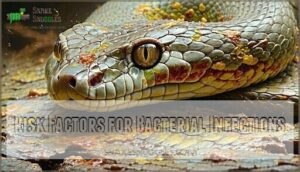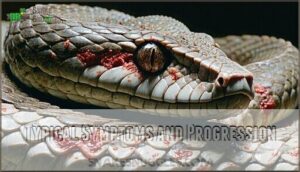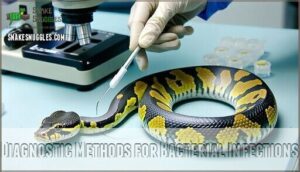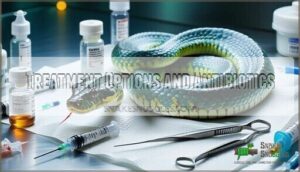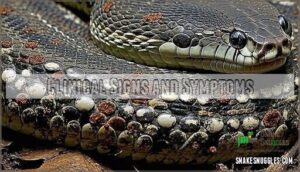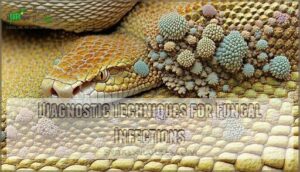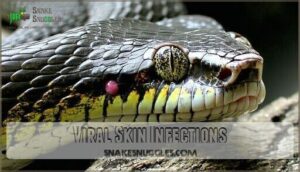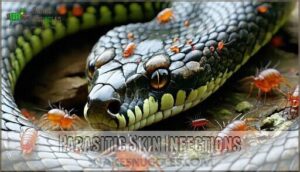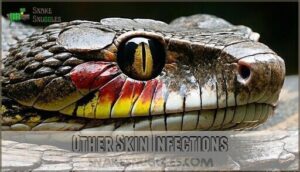This site is supported by our readers. We may earn a commission, at no cost to you, if you purchase through links.
 You’ll encounter five main types of snake skin infection that can threaten your pet’s health.
You’ll encounter five main types of snake skin infection that can threaten your pet’s health.
Bacterial infections cause blister disease and ulcerative dermatitis, often from poor husbandry conditions. Fungal infections, particularly from Ophidiomyces ophiodiicola, create crusty lesions and facial deformities.
Viral infections produce skin discoloration and abnormal shedding patterns. Parasitic infestations from mites and ticks cause irritation and secondary infections.
Finally, conditions like septicemic cutaneous ulcerative disease (SCUD) can prove fatal without prompt intervention. Each infection type presents distinct warning signs that savvy owners learn to recognize.
Understanding these subtle differences could mean the difference between a quick recovery and a veterinary emergency. Recognizing the signs of these infections, such as skin discoloration and abnormal shedding patterns, is crucial for prompt intervention.
Table Of Contents
- Key Takeaways
- Bacterial Skin Infections
- Fungal Skin Infections
- Viral Skin Infections
- Parasitic Skin Infections
- Other Skin Infections
- Frequently Asked Questions (FAQs)
- What does a skin infection look like on a snake?
- What are 6 common skin infections?
- What is the early stage of snake blister disease?
- How to tell if a snake has an infection?
- How do you treat a snake skin infection?
- What does snake fungal disease look like?
- What is a snake’s bacterial infection?
- What does a snake respiratory infection look like?
- How does inadequate humidity affect snake skin health?
- Are skin infections contagious between captive snakes?
- Conclusion
Key Takeaways
- You’ll face five main infection types – bacterial (blister disease), fungal (Ophidiomyces), viral (skin discoloration), parasitic (mites/ticks), and specialized conditions like SCUD that each require different treatment approaches.
- Poor husbandry creates most problems – excessive humidity, dirty substrates, contaminated water, and inadequate ventilation provide perfect breeding grounds for dangerous pathogens to flourish.
- Early recognition saves lives – watch for skin discoloration, abnormal shedding, crusty lesions, swelling, discharge, or behavioral changes like excessive rubbing that signal developing infections.
- Professional treatment’s essential – most infections require veterinary diagnosis through cultures, scraping, or molecular testing, followed by specific antibiotics, antifungals, or supportive care you can’t provide at home.
Bacterial Skin Infections
Bacterial infections pose serious risks to your snake’s health, often developing when poor husbandry creates ideal conditions for harmful microorganisms to flourish.
Poor husbandry turns your snake’s skin into a breeding ground for dangerous infections.
You’ll typically notice early signs like redness, swelling, or unusual discharge around affected skin areas before the infection spreads to deeper tissues, which can be indicated by unusual discharge.
Causes of Bacterial Dermatitis
Over 80% of bacterial dermatitis cases stem from prior trauma like bites, scratches, or cage abrasions that create entry points for infection sources.
Poor husbandry weakens your snake’s immune defenses while dirty environments harbor dangerous bacterial strains.
Moist, contaminated substrates combined with inadequate nutrition create perfect conditions for skin bacterial disease to flourish.
Understanding bacterial dermatitis causes is essential for effective prevention and treatment.
Common Bacterial Species Involved
Your snake’s skin lesions often result from specific bacterial types that thrive in poor conditions.
Pseudomonas, Aeromonas, and Staphylococcus species frequently cause skin bacterial disease through wounds or stress.
Proper bacterium identification helps prevent antibiotic resistance during infection control.
These pathogens differ from fungal skin disease and parasitic skin disease, requiring targeted treatment for effective snake skin infection management, which involves understanding the importance of infection control.
Risk Factors for Bacterial Infections
Several factors increase your snake’s vulnerability to bacterial skin infections. Poor hygiene creates the perfect breeding ground – dirty water bowls and soiled substrate harbor harmful bacteria that penetrate damaged skin.
Overcrowding and stress weaken your pet’s immune response, making infection control nearly impossible.
High humidity without proper ventilation promotes bacterial load growth, while injuries from rough handling create entry points for cellulitis development.
Typical Symptoms and Progression
Initial skin lesions appear as small, reddish spots that rapidly develop into deeper ulcerations.
Bacterial infection stages progress from superficial irritation to severe tissue necrosis within days.
You’ll notice symptom progression includes swelling, discharge, and darkening scales around wound sites.
Disease patterns typically spread along the snake’s body, compromising wound healing.
Without prompt treatment, infection stages advance to systemic sepsis, making early recognition essential for your snake’s survival.
Understanding snake skin infection products is key to managing skin infection treatments, and recognizing the importance of early recognition is crucial.
Diagnostic Methods for Bacterial Infections
When you notice suspicious skin lesions on your snake, proper diagnostic testing becomes your roadmap to recovery.
Veterinarians use bacterial tests including skin scraping and microbial culture to identify specific pathogens causing dermatological infections.
Diagnostic imaging helps assess deeper tissue involvement, while infection markers in wound samples confirm abscess infection severity for targeted treatment protocols, which is crucial for recovery.
Treatment Options and Antibiotics
Once bacterial tests confirm the infection, antibiotic therapy becomes your primary weapon against bacterial infections in reptiles.
Effective wound care requires daily cleaning and appropriate medical ointments to prevent secondary fungal infection.
Treatment protocols include:
- Systemic antibiotics based on culture sensitivity
- Topical antimicrobial solutions for localized lesions
- Surgical debridement for severe necrotic tissue
- Skin grafts for extensive damage in severe cases
Early intervention prevents complications and reduces treatment duration substantially.
Understanding the bacterial infection cure is vital for effective treatment and prevention of further complications.
Fungal Skin Infections
Fungal infections in snakes represent one of the most serious threats to reptile health, with Ophidiomyces ophiodiicola causing devastating outbreaks across multiple species.
You’ll find this pathogen particularly dangerous because it can spread rapidly through collections and often proves fatal without prompt, aggressive treatment.
Causative Agent Ophidiomyces Ophiodiicola
Ophidiomyces ophiodiicola represents the primary pathogenic fungus causing snake skin disease across North America.
This opportunistic organism thrives in humid environments, attacking compromised skin barriers through spores that penetrate damaged scales.
You’ll recognize this fungal infection through characteristic crusty lesions, abnormal shedding patterns, and facial swelling.
Mycological diagnosis requires specialized laboratory testing to confirm Ophidiomyces treatment protocols for your reptile’s infectious skin disease recovery.
Geographic Distribution and Affected Species
While snake fungal disease spreads across global snake habitats from eastern North America to Europe, your pet faces varying risks based on location and species susceptibility.
Regional outbreaks affect over 30 species, with environmental factors like humidity creating conservation impacts through severe mortality events in watersnakes and rattlesnakes.
A key indicator of the disease is facial swelling, which signals the presence of severe mortality events.
Clinical Signs and Symptoms
You’ll spot distinct lesions appearing as raised, brown-to-black crusty patches across your snake’s body.
These infection sites typically start small but spread rapidly, creating characteristic circular patterns.
The dermatitis signs include thickened scales, abnormal shedding cycles, and visible scale damage around affected areas.
Watch for developing skin ulcers beneath crusty formations, as these wound infection indicators suggest advanced fungal penetration requiring immediate attention to prevent further skin ulcers.
Diagnostic Techniques for Fungal Infections
Definitive diagnosis requires thorough fungal testing through multiple approaches.
You’ll need skin scraping samples for microscopy analysis, which reveals fungal elements like hyphae and spores.
Culture methods provide species identification, though they’re time-consuming, and molecular diagnostics offer rapid, accurate results for dermatophytosis confirmation.
These techniques collectively guarantee proper identification of reptile skin infection pathogens affecting your snake’s dermatological health.
Treatment Protocols and Challenges
Before tackling fungal infections, you’ll need thorough therapeutic options that address both immediate symptoms and long-term infection control.
Treatment presents unique challenges requiring specialized wound care protocols.
- Antifungal medications – Limited options available for reptile skin diseases
- Surgical debridement – Removing infected tissue to prevent spread
- Environmental modifications – Controlling humidity and temperature factors
- Supportive wound care – Daily cleaning and topical treatments
- Monitoring protocols – Tracking treatment progress and potential complications
Effective snake fungal infection treatment requires understanding of fungal disease management to improve treatment outcomes.
Viral Skin Infections
While bacterial and fungal infections often steal the spotlight, viral skin infections present their own unique challenges in snake care.
These infections can weaken your snake’s immune system and create secondary complications that require immediate veterinary attention.
Types of Viruses Affecting Snake Skin
Several virus types target snake skin with devastating effects.
Nidoviruses represent the most significant threat, affecting up to 37.7% of captive pythons and causing severe skin lesions alongside respiratory symptoms.
Arenaviruses trigger inclusion body disease, creating extensive dermatitis and moulting disorders.
Reoviruses contribute to necrotizing skin conditions, while herpesviruses and papillomaviruses cause ulcerative lesions and proliferative growths respectively.
Transmission Routes of Viral Infections
Viral infections spread through multiple pathways that you must understand to protect your reptiles.
Direct contact between infected and healthy snakes represents the primary transmission route for viral shedding. Fomite spread occurs when contaminated equipment, substrates, or handler tools transfer pathogens between enclosures.
Airborne transmission remains less common but possible in crowded facilities.
Vector-borne transmission through mites can introduce zoonotic infections alongside parasitic infections, complicating skin microbiology balance, which is a critical aspect of maintaining healthy reptiles and preventing the spread of parasitic infections.
Clinical Manifestations of Viral Dermatitis
Your snake’s viral dermatitis manifests through distinct skin lesions that appear as raised, discolored patches or shallow skin ulcers.
These viral lesions often develop irregular borders with surrounding skin inflammation, creating a mottled appearance.
Dermatitis symptoms include tissue swelling, abnormal shedding patterns, and potential viral shedding from affected areas.
Unlike bacterial infections, viral skin diseases typically progress slowly with characteristic vesicular formations, including tissue swelling and abnormal shedding patterns.
Diagnostic Approaches for Viral Skin Diseases
Diagnosing viral skin diseases requires systematic testing approaches.
Skin biopsy remains the gold standard for molecular analysis, allowing identification of specific viral particles through laboratory examination.
Serology tests detect antibodies indicating past or present viral infections.
Diagnostic imaging helps assess infection severity and tissue involvement.
Viral testing through PCR confirms pathogen presence, while dermatological evaluation documents clinical progression of snake skin diseases, using the laboratory examination to guide the process.
Management of Viral Skin Infections
Treatment options for viral skin infections remain limited since no specific antiviral medications exist for reptile viruses.
You’ll need to focus on infection control through supportive care and preventing secondary bacterial complications.
Managing viral load involves maintaining ideal environmental conditions while monitoring skin lesions for changes.
Different viral strains require varied approaches, but strengthening your snake’s immune system through proper husbandry remains the cornerstone of dermatological treatment protocols.
Parasitic Skin Infections
External parasites pose a significant threat to your snake’s health, with mites and ticks being the most common culprits that can weaken your pet’s immune system.
You’ll need to recognize the signs early and act quickly, as these parasites multiply rapidly and can transmit serious diseases between reptiles.
Common External Parasites Affecting Snake Skin
External parasites pose significant threats to your snake’s health, creating entry points for secondary snake skin infections.
These tiny invaders damage the integumentary system while weakening your pet’s immune response.
- Mite Infestations: Snake mites (Ophionyssus natricis) cause intense irritation and anemia
- Snake Lice: Rare but destructive parasites that feed on blood and tissue fluids
- Tick Borne: Hard ticks attach firmly, transmitting pathogens through feeding
- Skin Lesions: Parasitic feeding creates wounds susceptible to fungal infections and bacterial invasion
Life Cycles of Snake Mites and Ticks
Understanding parasitic life cycles helps you recognize when your snake’s at greatest risk.
Mite life cycle progression includes five stages: egg, larva, protonymph, deutonymph, and adult, completing in just 13-19 days under ideal conditions.
Tick biology involves four stages over two to three years.
Both snake parasites require specific temperature and humidity levels for successful development, making ectoparasite control possible through environmental management strategies.
Effective snake mite prevention involves understanding snake mite biology to break their life cycle and prevent infestations.
Symptoms of Parasitic Infestations
Vigilance becomes your best defense when parasitic infections threaten your snake’s well-being.
These unwelcome invaders create telltale signs that you can’t afford to miss.
- Behavioral Changes: Your snake becomes unusually restless, rubbing against surfaces excessively, or showing increased aggression during handling sessions
- Appetite Loss: Food refusal persists for multiple feeding cycles, accompanied by visible weight loss and decreased activity levels
- Shedding Issues: Incomplete or stuck shed occurs repeatedly, with skin appearing dull, patchy, or retaining old scales in problematic areas
- Lesion Appearance: Small red spots, swollen areas, or open wounds develop around scale edges, particularly near the mouth and vent regions
Secondary infections often follow untreated parasitic infestations, making early recognition vital for preventing serious skin disorders and maintaining your snake’s health.
Diagnosis of External Parasites
Three key methods enable accurate mite identification and tick detection in your snake.
Visual inspection reveals moving parasites on snake skin, while skin scrapes provide samples for microscopic analysis.
Fecal exams detect internal parasites that may cause secondary skin infection.
These diagnostic techniques help differentiate parasites from other causes of dermatitis, ensuring proper treatment for your snake’s health and facilitating effective dermatitis management.
Treatment Methods for Mite and Tick Infestations
When dealing with mite and tick infestations, you’ll need prompt veterinary consultation to determine appropriate acaricide options for your snake.
Effective treatment combines targeted medication with strict quarantine protocols to prevent spread.
Environmental control measures include thorough enclosure cleaning and substrate replacement.
Many owners find effective mite treatments helpful for eradication.
Your veterinarian will recommend specific preventative measures based on the parasite type affecting your snake’s skin.
Other Skin Infections
Beyond common bacterial, fungal, viral, and parasitic infections, you’ll encounter several other serious skin conditions that can threaten your snake’s health.
These specialized infections require immediate recognition and treatment to prevent permanent damage or death.
Septicemic Cutaneous Ulcerative Disease (SCUD)
SCUD causes severe skin breakdown when Aeromonas hydrophila bacteria overwhelm your snake’s immune system.
You’ll notice deep ulcers, red patches, and tissue death spreading rapidly across the ventral scales.
SCUD symptoms progress quickly from minor skin irritation to life-threatening sepsis.
Veterinary diagnosis requires bacterial culture and sensitivity testing to identify the specific pathogen.
Treatment demands aggressive antibiotic therapy, often requiring injectable medications for several weeks to prevent fatal complications.
Blister Disease in Snakes
Blister disease affects your snake’s ventral scales when prolonged exposure to moisture creates bacterial hotbeds.
You’ll notice fluid-filled lesions that can rupture and become infected wounds requiring immediate veterinary attention.
- Causes: Excessive humidity, poor drainage, contaminated water sources, inadequate ventilation, and unsanitary substrate conditions
- Symptoms: Fluid-filled blisters on belly scales, scale discoloration, eventual rupture leading to open sores, lethargy, and appetite loss
- Treatment: Topical antiseptics, systemic antibiotics for secondary infections, surgical drainage of large blisters, and supportive care protocols
- Prevention: Maintain proper humidity levels, guarantee adequate substrate drainage, regular habitat cleaning, and proper ventilation systems
- Environment: Monitor enclosure conditions daily, replace substrate frequently, provide dry hiding spots, and maintain temperature gradients appropriately
Necrotizing Fasciitis in Snakes
While blister disease creates surface-level damage, necrotizing fasciitis represents a far more aggressive threat.
This severe bacterial infection rapidly destroys deep skin layers and underlying tissues. Causes include gram-positive bacteria entering through wounds or bites.
Symptoms progress from localized swelling to tissue death within hours.
Diagnosis requires immediate veterinary examination and bacterial cultures. Treatment demands aggressive antibiotic therapy and surgical debridement.
Prevention focuses on maintaining sterile environments and prompt wound care.
Scale Rot in Snakes
Scale rot represents one of the most common snake skin infections you’ll encounter as a reptile owner. This bacterial condition primarily affects the ventral scales, creating brown or black discoloration that can spread rapidly without proper intervention.
Key identification markers include:
- Dark spots or patches on belly scales that feel soft or mushy
- Foul odor emanating from affected areas during handling
- Scale separation where infected scales lift away from healthy tissue
Causes stem from excessive moisture in enclosures, poor substrate choices, and inadequate cleaning routines. Symptoms progress from minor discoloration to serious tissue damage.
Treatment requires immediate veterinary care, antibiotic therapy, and environmental corrections. Prevention focuses on proper humidity levels and regular habitat maintenance.
Severity ranges from mild surface infections to life-threatening systemic conditions affecting internal organs.
Traumatic Skin Infections in Snakes
Physical injuries create entry points for bacteria, turning minor wounds into serious skin infections in reptiles.
**Even minor scrapes become infected highways when proper wound care isn’t prioritized.
Enclosure trauma from rough substrates or sharp decorations commonly causes abrasion infections.
Poor wound care leads to contamination, while bite complications from feeding accidents or territorial disputes require immediate veterinary medicine attention.
Burn infections from faulty heating equipment demand prompt treatment to prevent systemic spread throughout your snake’s body.
Owners should prioritize proper snake care to avoid complications, and visit proper snake care for more information on how to prevent serious skin infections and ensure the health of their reptiles, including the importance of addressing bite complications.
Emerging Snake Skin Pathogens
Several novel pathogens threaten snake populations worldwide.
Paranannizziopsis species now cause skin lesions similar to Ophidiomyces ophiodiicola, expanding diagnostic challenges.
Climate impact drives geographic spread while antibiotic resistance complicates treatment protocols.
Advanced molecular techniques enable rapid pathogen detection, supporting conservation concerns for endangered species.
These emerging snake skin infections demand vigilant monitoring and updated veterinary approaches.
Proper husbandry can help prevent bacterial skin infections, which is a critical concern for snake health, and addressing this issue is of utmost importance to prevent severe consequences.
Frequently Asked Questions (FAQs)
What does a skin infection look like on a snake?
You’ll notice infected snake skin shows crusty, thickened skin lesions with redness and swelling. Watch for discolored scales, fluid-filled blisters, or cloudy patches that don’t heal properly during shedding cycles.
What are 6 common skin infections?
You’ll encounter common skin infections like cellulitis, impetigo, folliculitis, athlete’s foot, ringworm, and bacterial boils.
These conditions stem from viruses, bacteria, fungi, and parasites breaking through your skin’s natural barrier defenses, leading to infections like impetigo.
What is the early stage of snake blister disease?
Something’s lurking beneath your snake’s belly that shouldn’t be there.
Early blister disease appears as small pustules or blisters that may resolve without ulceration if caught quickly.
You’ll spot red, inflamed skin with clear fluid-filled bumps, which is a key sign of the disease, particularly the presence of inflamed skin.
How to tell if a snake has an infection?
You’ll spot signs like patches of discolored scales, retained shed skin, swelling, discharge, lethargy, loss of appetite, breathing difficulties, or unusual behavior patterns that deviate from normal.
How do you treat a snake skin infection?
Studies show 70% of snake skin infections stem from improper humidity levels. You’ll need injectable antibiotics from a veterinarian for effective treatment, plus gentle cleaning with dilute antiseptic solutions twice daily.
What does snake fungal disease look like?
You’ll notice opaque eyes and hard, crusty scales on affected snakes. Facial swelling and lesions are most common signs, plus displaced or discolored scales, granulomas, and nodules under the skin.
What is a snake’s bacterial infection?
When a snake’s skin becomes a battlefield, you’re facing bacterial dermatitis. This superficial or deep infection appears as blister disease, belly rot, or ulcerative lesions requiring prompt antibiotic treatment.
What does a snake respiratory infection look like?
You’ll recognize respiratory infections through mouth breathing, wheezing sounds, and mucus discharge from the mouth or nostrils. Watch for lethargy, loss of appetite, and your snake holding its head upright.
How does inadequate humidity affect snake skin health?
Inadequate humidity causes your snake’s skin to become dry and brittle, leading to incomplete sheds, retained skin pieces, and potential infections.
You’ll notice flaky patches, difficulty shedding, and increased susceptibility to bacterial growth.
Are skin infections contagious between captive snakes?
While clean aquarium water and disease-free tankmates go hand in hand, you’re dealing with a complex transmission puzzle.
Yes, many infections spread between captive snakes through direct contact and contaminated environments.
Always quarantine new arrivals and disinfect shared equipment to prevent the spread of disease.
Conclusion
Picture a healthy snake’s scales glistening like polished armor under terrarium lights – now imagine that protection compromised by disease.
Understanding these five types of snake skin infection empowers you to safeguard your reptile’s health, including bacterial, fungal, viral, and parasitic conditions.
Bacterial, fungal, viral, parasitic, and specialized conditions like SCUD each demand specific recognition and treatment approaches.
You’ll spot early warning signs faster, respond more effectively, and prevent minor issues from becoming life-threatening emergencies.
Your vigilance protects your snake’s most essential barrier.
- https://www.usgs.gov/diseases-of-terrestrial-wildlife/snake-fungal-disease
- https://dnr.wisconsin.gov/sites/default/files/topic/EndangeredResources/sfdInWisconsin.pdf
- https://www.frontiersin.org/journals/fungal-biology/articles/10.3389/ffunb.2023.1064939/full
- https://www.nature.com/articles/s41598-018-30709-x
- https://www.merckvetmanual.com/all-other-pets/reptiles/disorders-and-diseases-of-reptiles

